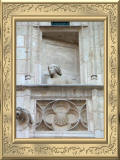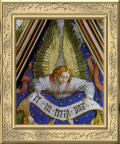|
He was born at Bourges, the city where his father, Pierre Cœur, was
a rich merchant. Jacques is first heard of around 1418, when he
married Mace de Lodepart, daughter of Lambert de Lodepart, an
influential citizen, provost of Bourges and a former valet of John,
Duke of Berry.
|
 |
 |
 |
|
Macée de Leopart
wife of
Jacques Coeur |
Jacques Coeur
looking out of the gatehouse
(at the Palace) |
beside him his wife
Macée Coeur |
About
1429 he formed a commercial partnership with two
brothers named Godard; and in 1432 he was at
Damascus, buying and bartering, and transporting the
wares of the Levant—gall-nuts, wools and silks,
mohair, brocades and carpets—to the interior of
France by way of Narbonne. In the same year he
established himself at Montpellier, and there began
the gigantic operations which have made him
illustrious among financiers. Details are wanting;
but it is certain that in a few years he placed his
country in a position to contend fairly well with
the great trading republics of Italy, and acquired
such a reputation as to be able, mere trader as he
was, to render material assistance to the knights of
Rhodes and to Venice itself.
|
 |
 |
 |
|
Chimney
in the banqueting hall -
decorated with floral designs with royal
emblems
|
Palace of
Jacques Coeur
21th century |
Sculpture
of a young woman, playing the lute
- façade
of the palace |
In 1436 Cœur was
summoned to Paris by Charles VII, and made master of the mint. This
post was of great importance, and the duties onerous. The country
was deluged with base monies from three reigns, charged with
superscriptions both French and English, and Charles was determined
to make sweeping reforms. In this design he was ably seconded by the
merchant, who, in fact, inspired or prepared all the ordinances
concerning the coinage of France issued between 1435 and 1451. In
1438 he was made steward of the royal expenditure; in 1441 he and
his family were ennobled by letters patent. In 1444 he was sent as
one of the royal commissioners to preside over the new parliament of
Languedoc, a position he held till the day of his disgrace. In 1445
his agents in the East negotiated a treaty between the sultan of
Egypt and the knights of Rhodes; and in 1447, at his insistence,
Jean de Village, his nephew by marriage, was charged with a mission
to Egypt. The results were most important; concessions were obtained
which greatly improved the position of the French consuls in the
Levant, and that influence in the East was thereby founded which,
though often interrupted, was for several centuries a major
commercial glory for France. In the same year, Cœur assisted in an
embassy to Amadeus VIII, former duke of Savoy, who had been chosen
Pope as Felix V by the council of Basel and in 1448 he represented
the French king at the court of Pope Nicholas V where he was able to
arrange an agreement between Nicholas and Amadeus, and so end the
papal schism. Nicholas treated him with the utmost distinction,
lodged him in the papal palace, and gave him special licence to
traffic with the infidels. From about this time he made advances to
Charles to carry on his wars and in 1449, after fighting at the
King's side throughout the campaign, he entered Rouen in Charles'
triumphal procession.
At this point, the great trader's glory was at
its height. He had represented France in three embassies, and had
supplied the sinews of the war which had ousted the English from
Normandy. He was invested with various offices of state, and
possessed the most colossal fortune that had ever been amassed by a
private Frenchman. The sea was covered with his ships; he had 300
managers in his employ, and business houses in all the chief cities
of France. He had built houses and chapels, and had founded colleges
in Paris, at Montpellier and at Bourges. The house in Bourges was
exceptionally magnificent and remains to-day one of the finest
monuments of the Middle Ages in France. He also built there the
sacristy of the cathedral and a sepulchral chapel for his family.
His brother Nicholas Cœur was made bishop of Lyon, his sister
married Jean Bochetel, the King's secretary, his daughter married
the son of the Viscount of Bourges, and his son Jean Cœur became
archbishop of Bourges. But Cœur's huge monopoly caused his ruin.
Dealing in everything: money and arms, furs and jewels, brocades and
wool, a broker, a banker, a farmer, he had absorbed the trade of the
country, and merchants complained they could make no profit because
of him. He had lent money to needy courtiers, to members of the
royal family, and to the King himself, and his debtors, jealous of
his wealth, were eager for a chance to cause his downfall.
|
 |
 |
 |
|
Charles VII
and his wife
Marie d'Anjou
by Guillaume 1455-60 |
The chapel
painted vault
inscribed with a passage the
"Gloria in exelsis Deo"
|
Priams's fleet
French manuscript
(15th century)
|
In
February 1450 Agnès Sorel, the King's mistress,
suddenly died. Eighteen months later it was rumoured
that she had been poisoned, and a lady of the court
who owed money to Jacques Cœur, Jeanne de Vendôme,
wife of François de Montberon, and an Italian,
Jacques Colonna, formally accused him of having
poisoned her. There was no pretext for such a charge,
but for this and other alleged crimes the King, on
31 July 1451, gave orders for his arrest and for the
seizure of his goods, reserving for himself a large
sum of money for the war in Guienne. Commissioners
extraordinary, the merchant's declared enemies, were
chosen to conduct the trial and an inquiry began,
the judges in which were either the prisoner's
debtors or the holders of his forfeited estates. He
was accused of having paid French gold and ingots to
the infidels, of coining light money, of kidnapping
oarsmen for his galleys, of sending back a Christian
slave who had taken sanctuary on board one of his
ships, and of committing frauds and exactions in
Languedoc to the King's prejudice. He defended
himself with all the energy of his nature. His
innocence was manifest but a conviction was
necessary, and in spite of strenuous efforts on the
part of his friends, after twenty-two months of
confinement in five prisons, he was condemned to do
public penance for his fault, to pay the King a sum
equal to about 1,000,000 at today's value, and to
remain a prisoner till full satisfaction had been
obtained. His sentence also included confiscation of
all his property, and exile during His Majesty's
pleasure.On 5 June 1453 the
sentence took effect. At Poitiers, the shame of making honourable
amends was accomplished and for nearly three years nothing is known
of him. It is probable that he remained in prison. It is certain
that his vast possessions were distributed among the intimates of
Charles.
|
 |
 |
 |
 |
|
Ile of Chios
and harbour |
signature and seal of
Jacques Coeur
|
façade
of the Palace
(ca. 1470)
book of hours of the Coeur
family |
Palace of
Jacques Coeur
21th century |
|
In 1455 Jacques
Cœur, wherever confined, contrived to escape into Provence.
He was pursued, but a party headed by Jean de Village and
two of his old managers, carried him off to Tarascon, whence,
by way of Marseilles, Nice and Pisa, he managed to reach
Rome. He was honorably and joyfully received by Nicholas V.,
who was fitting out an expedition against the Turks. On the
death of Nicholas, Calixtus III continued his work, and made
his guest, Cœur, captain of a fleet of sixteen galleys sent
to the relief of Rhodes. Cœur set out on this expedition,
but was taken ill at Chios, and died there on 25 November
1456. After his death Charles VII showed himself well
disposed to the family, and allowed Jacques Cœur's sons to
inherit whatever was left of their father's wealth. |
Jacques Coeur
died 25
novembre 1456

Jacques Coeur
by the sculptor Auguste Préault
the statue was installed in 1879
|
I would like to send Marie-France
from France, a faithful visitors of the Catherine de
Montsalvy, my heartfelt thank you for sending me her
personal material about Jacques Coeur. A special thank
you also to her daughter Amandine for the beautiful
photos. I enjoyed also very much the beautiful booklet from
Bourges about the Palace of Jacques Coeur.
|

return
Wikipedia and various sources of
the Internet 2012
©
2008
- 2023 linda compagnoni walther
non profit site
all rights reserved
design by Evelyne Diggelmann-Waltherr
|
